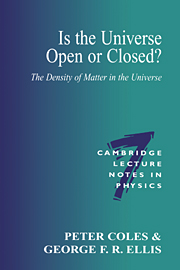6 - Large-scale structure
Published online by Cambridge University Press: 25 January 2010
Summary
We now turn our attention to the evidence from observations of galaxy clustering and peculiar motions on very large scales. In recent years this field has generated a large number of estimates of Ω0 many of which are consistent with unity. Since these studies probe larger scales than the dynamical measurements discussed in Chapter 5, one might be tempted to take the large-scale structure as providing truer indications of the cosmological density of matter. On the other hand, it is at large scales that accurate data are hardest to obtain. Moreover, very large scale structures are not fully evolved dynamically, so one cannot safely employ equilibrium arguments in this case. The result is that one is generally forced to employ simplified dynamical arguments (based on perturbation theory), introduce various modelling assumptions into the analysis, and in many cases adopt a statistical approach. The global value of Ω0 is just one of several parameters upon which the development of galaxy clustering depends, so results are likely to be less direct than obtained by other approaches. Moreover, it may turn out that the gravitational instability paradigm, which forms the basis of the discussion in this chapter, is not the right way to talk about structure formation. Perhaps some additional factor, such as a primordial magnetic field (Coles 1992) plays the dominant role. Nevertheless, there is a persuasive simplicity about the standard picture and it seems to accommodate many diverse aspects of clustering evolution, so we shall accept it for the sake of this argument.
- Type
- Chapter
- Information
- Is the Universe Open or Closed?The Density of Matter in the Universe, pp. 111 - 148Publisher: Cambridge University PressPrint publication year: 1997



